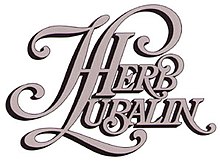Herb Lubalin
| Herb Lubalin | |
|---|---|

Herb Lubalin's studio logo.
|
|
| Born |
Herbert F. (Herb) Lubalin March 17, 1918 |
| Died | May 24, 1981 (aged 63) |
| Occupation | Type designer, graphic designer |
Herbert F. (Herb) Lubalin (pron. "loo-ba'-len"; March 17, 1918 – May 24, 1981) was an American graphic designer. He collaborated with Ralph Ginzburg on three of Ginzburg's magazines: Eros, Fact, and Avant Garde, and was responsible for the creative visual beauty of these publications. He designed a typeface, ITC Avant Garde, for the last of these; this font could be described as a reproduction of art-deco, and is seen in logos created in the 1990s and 2000s.
Herb Lubalin entered Cooper Union at the age of seventeen, and quickly became entranced by the possibilities presented by typography as a communicative implement. Gertrude Snyder notes that during this period Lubalin was particularly struck by the differences in interpretation one could impose by changing from one typeface to another, always “fascinated by the look and sound of words (as he) expanded their message with typographic impact.” After graduating in 1939, Lubalin had a difficult time finding work; he was fired from his job at a display firm after requesting a two dollar raise on his weekly salary, up from a paltry eight (around USD100 in 2006 currency). Lubalin would eventually land at Reiss Advertising, and later worked for Sudler & Hennessey, where he practiced his considerable skills and attracted an array of design, typographic and photographic talent that included George Lois, Art Kane and John Pistilli. He served with Sudler for nineteen years before leaving to start his own firm, Herb Lubalin, Inc., in 1964 .
Lubalin’s private studio gave him the freedom to take on any number of wide-ranging projects, from poster and magazine design to packaging and identity solutions. It was here that the designer became best known, particularly for his work with a succession of magazines published by Ralph Ginzburg: Eros, Fact, and Avant Garde.Eros, (Spring 1962 to issue four 1963) which devoted itself to the beauty of the rising sense of sexuality and experimentation, particularly in the burgeoning counterculture, it was a quality production with no advertising and the large format (13 by 10 inches) made it look like a book rather than a quarterly magazine. It was printed on different papers and the editorial design was some the greatest that Lubalin ever did. It quickly folded after an obscenity case brought by the US Postal Service. Ginzburg and Lubalin followed with Fact, largely founded in response to the treatment Eros received. This magazine’s inherent anti-establishment sentiment lent itself to outsider writers who could not be published in mainstream media; Fact managing editor Warren Boroson noted that “most American magazine, emulating the Reader's Digest, wallow in sugar and everything nice; Fact has had the spice all to itself.” Rather than follow with a shocking design template for the publication, Lubalin chose an elegant minimalist palette consisting of dynamic serifed typography balanced by high-quality illustrations. The magazine was printed on a budget, so Lubalin stuck with black and white printing on uncoated paper, as well as limiting himself to one or two typefaces and paying a single artist to handle all illustrations at bulk rate rather than dealing with multiple creators. The end result was one of dynamic minimalism that emphasized the underlying sentiment of the magazine better than “the scruffy homemade look of the underground press (or the) screaming typography of sensationalist tabloids” ever could.Fact itself folded in controversy as Eros before it, after being sued for several years by Barry Goldwater, the Republican presidential candidate about whom Fact wrote an article entitled “The Unconscious of a Conservative: A special Issue on the Mind of Barry Goldwater.” Goldwater was awarded a total of $90,000, effectively putting Fact out of business.
...
Wikipedia
